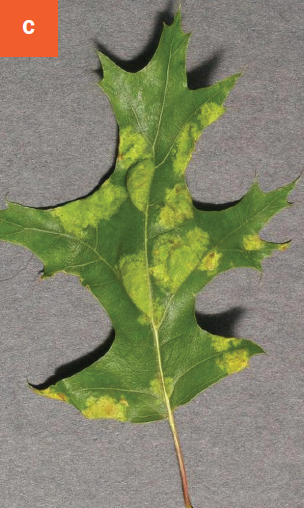Oak Leaf Blister
Taphrina caerulescens (fungus)
HOST Oak
DAMAGE/SYMPTOMS Symptoms appear early in the summer as blisters, bulges, or depressions on the upper leaf surface. The lower side of the leaves turns a grayish color in affected areas. The blistered areas may merge and change color from yellow to brown over time. Infection may also result in leaf distortion. Mature leaves are usually resistant to infection.
DISEASE CYCLE The fungus overwinters in infected buds, bud scales, and leaf debris. Spores are dispersed in spring and infect newly emerging leaves just after bud break. Infection is most severe under cool, wet conditions. Blisters form on the leaves and produce new spores by midsummer.
MANAGEMENT This disease may be unsightly, but it typically does not cause severe damage. Remove infected leaves that fall onto the ground to reduce the level of infection. Avoid wetting the foliage for prolonged times. Fungicides are not usually recommended unless the disease is a continuing problem. High value trees can be treated with a fungicide application in early spring when the buds start to swell. Products with the active ingredient chlorothalonil are effective in controlling this disease. Strictly follow instructions on the pesticide labels.
A Young blisters appear on leaves after infection. B Large areas on leaves affected by oak leaf blister disease. C Blisters on upper surface of an oak leaf. D Gray-green areas of blisters on the lower surface of an oak leaf.




